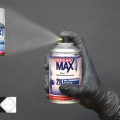How should we handle an aerosol in order not to run any risk?
For decades, the use of aerosols has been widespread in our homes. These products are generally effective and safe if used properly. However, they can present real risks to the home if used incorrectly and could cause a domestic accident, so their handling should be taken seriously.
A good example is insecticide aerosol sprays with a full release valve (foggers), also known as bug bombs. These are pesticides that contain propellants that release their entire contents at once to spray an area.
When an aerosol can containing a gas at room temperature experiences an aggressive change in temperature, it will seek to expand or blow out in a violent manner, thereby generating an explosion.
Improper use of these aerosol type foggers can cause a fire or explosion, as the propellants are generally flammable. In addition to this risk, there is a risk of illness if the site is not left during unloading or is subsequently entered without ventilating the site.
Do not use more insecticide spray than necessary.
Aerosol insecticide use accidents with a full discharge valve (fogger type) usually occur in cases where the user releases too much mist, causing flammable vapors to accumulate. Aerosols come in different sizes. Before use it is advisable to read the label carefully for a correct use suitable for the space where it is going to be used.
Insecticide sprays should not be applied in small, enclosed areas, such as walk-in closets, cabinets, or under countertops or tables. Use of an aerosol insecticide in an unventilated space may cause the product to explode and result in injury to persons or damage to property.
Away from sources of ignition
Accidents are more likely to occur if large amounts of insecticide spray (fogger) come into direct contact with an ignition source, such as a flame, pilot light, or spark from an electrical appliance that cycles on and off (e.g., a refrigerator or air conditioner).
The Environmental Protection Agency recommends locating insecticide spray ten feet or more away from any source of ignition. Breathing aerosol vapor may be harmful. Safe use of these products requires that all people and pets leave the area to be treated and close the doors after unloading the insecticide spray. You will have to wait between two and four hours to return, there is a risk as it can cause illness.
Ventilate the area
When you have returned to the treated area, open doors and windows to vent any remaining fumes. Placing fans in the doors may help ventilate the area and remove fumes.
If you store it in a horizontal position, the internal particles will reach the valve, obstructing the passage of the product. That is why it is important to store it in an upright position. Don’t forget to always shake the product before use for best results. It should be noted that when the valve is shaken and then pressed, the contents change from a liquid to a gaseous state.
This creates a pressure that will be released quickly with just a flick of the finger. If you do not shake the product, you will only get a simple gas that will not allow you to enjoy the benefits of what you have purchased.
Avoids possible damage
If you mistakenly spray the contents of the container you purchased on your face or any other part of your body that is affected, it is vital that you go to a medical facility immediately. Don’t procrastinate.
Do it as soon as possible, because it will be the specialist who will determine the severity of the issue and provide you with a treatment for the condition. Strictly avoid self-medication.











